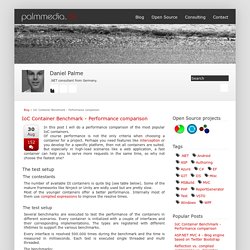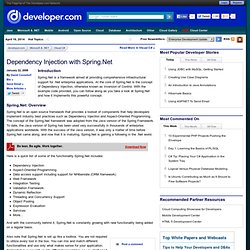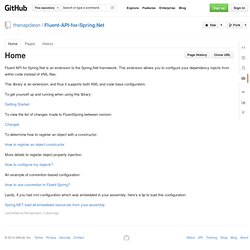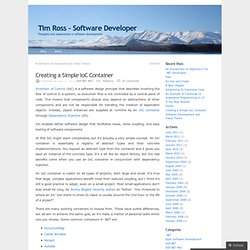

Anthony Steele's Blog - Comparing .Net IoC containers, part zero: Groundwork. I started doing some compare and contrast code on well-known .Net Inversion Of Control containers some time in 2009, in order to better convince my colleagues that they should be using a good one.

I haven't succeeded yet, but I have reworked the code into a simple and practical survey that may be of use to anyone interested in picking an Inversion of Control Container for .Net code. In general I'm only looking at basic features, and the syntax used to access them, but I hope it's enough to get a feel for each one's strengths and weaknesses. This article isn't aimed at teaching what an IoC container is or why you would want one; but in brief, Dependency Injection is the pattern of supplying an object's dependencies to it, usually via the constructor. Inversion of control (IOC containers) .NET IOC patterns. Sep IoC is not a new concept, however. It has been around for several years now. Using object-oriented design principles and features such as interface, inheritance, and polymorphism, the IoC pattern enables better software design that facilitates reuse, loose coupling, and easy testing of software components. This article discusses IoC and demonstrates how to use this pattern in your software design without having to implement any of the open source frameworks.
Simple Injector. Simple Injector - Performance. In this post I will do a performance comparison of the most popular IoC containers.Of course performance is not the only criteria when choosing a container for a project.

Perhaps you need features like interception or you develop for a specific platform, then not all containers are suited. But especially in high-load scenarios like a web application, a fast container can help you to serve more requests in the same time, so why not choose the fastest one? The test setup The contestants The number of available DI containers is quite big (see table below). The test setup Several benchmarks are executed to test the performance of the containers in different scenarios. Every interface is resolved 500.000 times during the benchmark and the time is measured in milliseconds. The benchmarks: The results Overview Basic features Advanced features Prepare Feature comparison Conclusion Ninject is definitely the slowest container.
Simple Injector. Introduction The Simple Injector is an easy-to-use Inversion of Control (IoC) library for .NET and Silverlight.

It solely supports code-based configuration, and is an ideal starting point for both developers unfamiliar with larger IoC / DI libraries and for developers who seek to apply the SOLID design principles to their applications. Many development teams are already using Simple Injector in their production environments today with great satisfaction. This article will describes the rationale behind the Simple Injector, the usage, and the actual implementation. This article will not explain the concept of Dependency Injection (DI). Background Many development teams I help have legacy code bases with few or no unit tests. To get teams on the road quickly, I often want to do the simplest thing that could possibly work. Dependency injection - Simple Injector vs Hiro vs Autofac. Dependency Injection with Spring.Net.
Introduction.

Spring-recoil - Fluent configuraton API for Spring.NET. Version 1.1.3 is released!

Grab it here: 1.1.3 - It comes with initializer method support (many thanks to Graham Nash) and object configuration inheritance (many thanks to Maxim Klyuchnikov) Contribution Feedback and even contribution are both very much welcome, as they are the only way to make Recoil better. If you have ideas, objections or comments, feel free to stop by at the Discussion. The source is kept in a Mercurial repository that you can easily retrieve. Patches If you found a bug or made a quick improvement, the easiest way to have it included in the next release is to send a patch to the project owners or contributors. Getting started Installation There is no real installation neccessary, apart from downloading the binaries and adding a reference to your project. Fluent-API-for-Spring.Net Wiki. Fluent API for Spring.Net is an extension to the Spring.Net framework.

This extension allows you to configure your dependency injects from within code instead of XML files. This library is an extension, and thus it supports both XML and code base configuration. To get yourself up and running when using this library: Getting Started To view the list of changes made to FluentSpring between version: Changes. Spring.NET - Application Framework. IoC Container Benchmark - Performance comparison - www.palmmedia.de. SpringSource.org. Creating a Simple IoC Container « Tim Ross – Software Developer. Inversion of Control (IoC) is a software design principle that describes inverting the flow of control in a system, so execution flow is not controlled by a central piece of code.

This means that components should only depend on abstractions of other components and are not be responsible for handling the creation of dependent objects. Instead, object instances are supplied at runtime by an IoC container through Dependency Injection (DI). IoC enables better software design that facilitates reuse, loose coupling, and easy testing of software components.